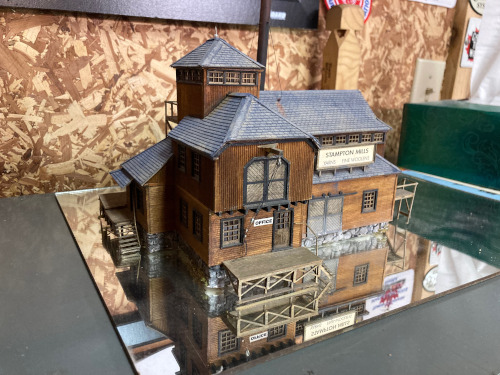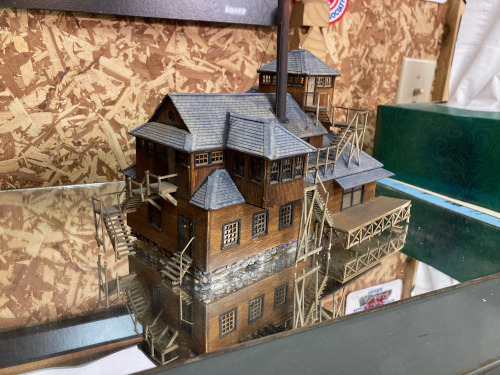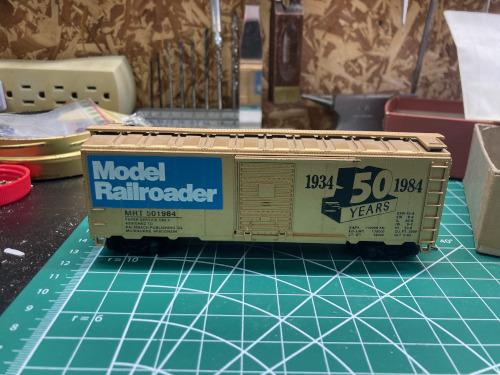Bruce Shepard
HO Scale
Bruce Shepard of the Lakeshores Division scratch built his HO scale “Allied Electroplating" structure/diorama using Evergreen styrene sheeting over a skeleton of black foam core board.
The finish was accomplished using the hair spray paint chipping technique. The foundation/loading dock was cut from foam core, wrapped with masking tape and then stippled with artist gesso. After painting and weathering this gives a nice dilapidated concrete appearance. The end staircase was assembled from scale lumber. On the diorama base I used a combination of dirt, static grass, and commercial grass tufts.
Bill Brown, MMR
HO scale
SASSI TRESTLE – Rio Grande C-19s # 343 and 345 creep across the wooden trestle in late 1949 on their way from Howardsville back to Silverton with several coal loads drawn from the Gold Prince Mill on Bill Brown MMR’s narrow gauge expanse. The trestle was originally built by Lou Sassi and was gifted to Bill when Lou relocated south. The engines and rolling stock are from Blackstone.
ELWELL PACKAGING – A Leadville and Red Cliff boxcar delivers supplies to the Elwell Packaging plant just outside of Pueblo on Bill Brown MMR’s LARC Layout. The building on the left was originally a creamery built by Dick Elwell and acquired by Bill upon Dick’s passing.
SALIDA – The city of Salida Colorado seems to have escaped the region’s first snowfall that took over the high peaks overnight. Soon the leaves will quickly change as winter approaches on Bill Brown MMR’s creation. Goods are being loaded to boxcars at the shipping terminal that fronts the storage yard for narrow gauge trains that are taking the day off from the tourist runs over Marshall pass. The passenger and boxcars cars are from Blackstone and the partially hidden caboose is a gift from Bob Hamm MMR. The backdrop was created by Bill from his archives of photos from his LARC Products backdrop company.
DURANGO ROUNDHOUSE – Mikado #462 emerges from the Durango roundhouse on an early summer morning 1n 1949 on Bill Brown MMR’s Colorado Narrow Gauge layout. The locos are all from Blackstone and the Galloping Goose is from Concor. The roundhouse was scratchbuilt by Bill, and the backdrop was produced by Bill’s company LARC Products.
HEIDT FABRICATORS – Workers are busy with their daily routine at Heidt’s Fabricators on the Leadville and Red Cliff Railroad of Bill Brown MMR. Bill created the structures taken from a Fine Scale Miniatures kit in order to honor the late Jim Heidt…past Superintendent and longtime stalwart of the Central New York Division.
Ed O'Rourke, MMR
Ed posted a picture of this kit to the NMRA Facebook group and found out it is “Scott Wire and Cable” a kit originally produced by Precision Laser Craft. It was built for and given to Jim Heidt by one of the early workers on his Ogdensburg and Norwood Tuesday night group. It was never installed on the layout and got pretty well beat up over the years. After Jim passed Ed salvaged it, repaired the damage and did some painting and weathering. It will eventually find a home on his new layout.
HO scale
The MR and NMRA cars came from the father of a friend of Ed's. The father died recently in his late ’90’s and the friend gave these to Ed. The 1969 National convention was in Minneapolis.
HO scale
The first picture is from the last run on Ed's old layout before it was taken down before his move to his new house. The final picture is an NER baggage car that was discovered at Jim Heidt's house.
Chris Carfaro
O Scale
Chris Carfaro custom painting this batch of hoppers for a friend. The photos are from a batch of 24 pieces of rolling stock currently being painted.
All six are Atlas O scale Cylindrical hoppers with the following process.
- Brought to NMRA weight, wheels and coupler standards as part of the disassembly.
- Paint is then Stripped, repainted, decaled using Highball Graphics and then weathered with airbrush and pan pastels.
- Decals and weathering is given a light coat of Tamiya flat finish.
- The Agway diamond shaped herald decals were hand made - based upon customer’s request.
- On the Penn Central hoppers of the same colors, one was weathered to be only a year old, where the second one is weathered to represent several years on the railroad.
Ted DiMone
This model is 1/48 scale, Lazer printed walls and tower. There is no other like it. It was printed by a gentleman that remains to be anonymous at this time.
It is completely scratch built. Real clocks in each side of the tower. Evans Designs lighting. Trees are from Grand Central Gems. All figures are hand painted by Ted and manufactured by Model-U in Great Britian, and are 1/48.5 British O scale…. Vallejo Paints, and Ammo, Real concrete product is the sidewalk. The sign is from Miller Engineering’..
Mark Sklar
The New York Central HO scale diner cars were designed and 3D printed by Mark Sklar (Hudson Berkshire Division). The cars are built in four pieces, body, undercarriage, interior tables with kitchen, and diaphragms. The undercarriage brake gear, tanks, generator, battery boxes, bolsters, etc. were all 3D printed as one piece. The trucks are Walthers type 2411 heavyweight 6-wheel passenger trucks. Interior lights were designed and built to be flicker free using LEDs. Wire handrails were added after painting. The windows are cut from microscope glass cover slides.
Dennis Colucci
Dennis has been a member of the NMRA's Hudson Valley Division for nearly two years now, and models in N Scale. He has been mostly working on locomotives recently. Firstly, a New Haven R-3 Mountain 3550. A Bachmann USRA Model, the locomotive came painted for the NYO&W Railroad. He started by removing the existing lettering with a light brushing of isopropyl alcohol and light rubbing with a pencil eraser. He also painted over the shiny silver on the cylinder caps with a gunmetal gray mix of acrylic paint. He then replaced the lettering using Microscale decals, lettering the locomotive for the New Haven. He then removed the existing bell above the locomotive's headlight. He replaced the bell with a brass part, about halfway back along the boiler, drilling a small hole in the boiler to mount the bell on. He added a brass feedwater heater above the headlight, and painted both parts black. Finally, he weathered the locomotive with Tamiya weathering powders.
Next up is Amtrak 4316. A well known loco, this was the first time Dennis ever really kitbashed a locomotive, and is still a work in progress as far as some small details go. This project started life as a Life Like Union Pacific E8. Using styrene and modeling putty, he filled the porthole windows, and did the same for the lower headlight on the locomotive. He then shaved and sanded off the molded-on grills. He let the locomotive bathe in isopropyl alcohol and scrubbed off the existing paint, and then painted the whole thing black. He then replaced the old grilles with Farre-style etched metal grilles. and started adding small details, like M.U. cables and grab irons. Finally, he added Fusion Scale Graphics decals to bring the locomotive to the "finished" state it is in now.
The final two projects are a pair of custom painted locomotives for Dennis's own railroad, the Balfour and Colucci Creek Southern or B&CCS. B30-7 501 and B40-8 560 are only the most recent locomotives he has repainted. They began their life as Atlas models, a Cotton Belt and BC Rail locomotive respectively. They both received alcohol baths and scrubs to remove the existing paint, then added his own custom paints. Using custom decals he designed and had printed by Fusion Scale Graphics, He lettered the locomotives. Finally, he added weathering, a combination of panel liners, paint, and powders. The Dash 8 is a new acquisition by the B&CCS, so it has very light weathering, while 501 shows the wear of years of service.
James Whatley, MMR
London and Port Stanley Railway Boxcab Electric L1
James completed this scratchbuilt HO scale model of a 1915 General Electric boxcab locomotive in February, 2020, based on numerous field measurements of the prototype preserved at the Elgin County Railway Museum in St. Thomas, Ontario. The only non-scratchbuilt items were one pair of Kadee couplers, two NWSL Stanton drive gearbox-motor-wheel assemblies, two lightbulbs, some 40-link/inch chain, metal shapes, and several small screws.
The frame is brass and is detailed with brake rigging, piping, electrical equipment, and conduits. The truck side frames are homemade resin castings, along with the steps, and several other small fittings. The car body is mostly styrene, with homemade etched brass window sashes and panes cut from microscope slide cover glass. Rivets are Archer surface decals. Both cab interiors are detailled with seats, sandboxes and controllers made from styrene and brass. The roof is brass formed over a wood core. The bell and headlights were turned on a lathe, with additional parts added. The working pantographs were scratchbuilt from brass channel, turned and hand filed brass fittings, and phosphor bronze wire. The elbows pivot on 0.55 mm watchmakers’ screws secured with tiny specs of blue thread locker. The contactor and arcing horns were cut and filed from 0.015” nickel silver sheet. The springs were formed over a 00-90 screw. The insulators were turned from Delrin rod.
The locomotive was painted and weathered using an airbrush and Humbrol enamel paints applied over Tamiya metal primer. Decals were pieced together from a Microscale alphabet set.












































